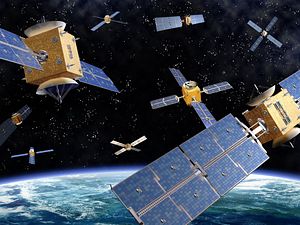Space junk, though invisible to us on Earth, poses a significant danger to both global communications networks and the lives of astronauts. Japan’s space agency has partnered with a fishing equipment company in an effort to rein in some of the orbiting debris.
Back in 2011, the Japan Aerospace Exploration Agency (JAXA) joined forces with Nitto Seimo – a fishing equipment company renowned for its durable fishing nets. Together, they have developed a special net that will theoretically be able to capture a portion of the estimated 100 million pieces of man-made trash orbiting our planet.
The first test of this high-tech “fishing” gear is scheduled for late February.
“[It] will involve launching a satellite into space that will unravel a net about 980 feet long that will create a magnetic field to attract space debris,” wrote The International Business Times. “The net, which is made of three strong and flexible metal fibers, will be in Earth’s orbit for about a year before being pulled down by Earth’s gravity, which will incinerate the captured debris.”
Just how serious is the space junk problem? According to NASA’s Orbital Debris Program, the area of space that exists between 900 and 1000 kilometers from our planet’s surface has already reached “supercritical” debris density levels. That band is a part of what scientists call the Lower Earth Orbit (LEO), where most satellites – as well as the International Space Station – are situated.
NASA estimates that a piece of space junk larger than 1 cm in diameter will strike a satellite in LEO every five or six years.
“A one-centimeter piece of debris doesn’t sound like much … but orbital speeds in LEO are typically greater than 7 kilometers per second – 30 times faster than a jet aircraft,” said Discovery News. “A speck of paint from a satellite once dug a pit in a space shuttle window nearly a quarter-inch wide.”
In theory, something as small as a metal bolt has the potential to knock out communication satellites (rendering many smartphones useless), satellites used for weather forecasting, GPS systems, and television signals. The floating shrapnel created when two satellites collide could even cause a “chain reaction” that renders some orbits unusable.
Large debris could even rip a hole in the space station, putting astronauts’ lives in danger.
According to JAXA’s website, the Japanese space program is looking into several other methods for cleaning up space trash. They include an “electrodynamic tether” that would slow down debris enough to make it re-enter the atmosphere and a satellite with ion engines that could use its thruster to knock objects into a lower orbit.
An even more far-fetched idea involves a giant “Styrofoam ball, kilometers in diameter” that debris would stick to.
If upcoming tests are successful, JAXA’s magnetic garbage net could be deployed as early as 2019.

































